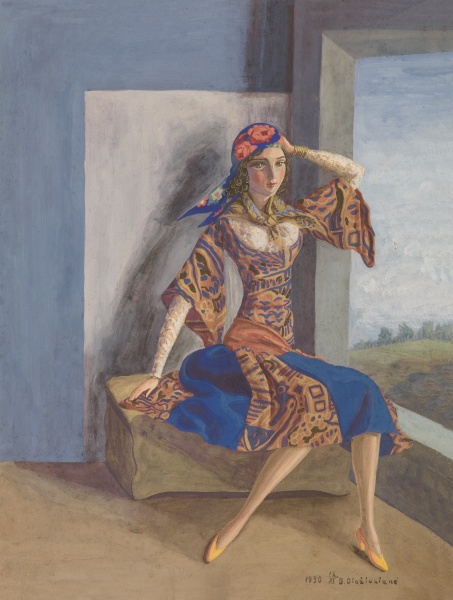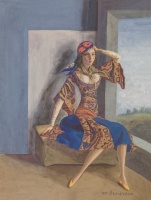
Woman at a window
| Author: |
Barbora Didžiokienė (1896–1976) |
| Created: | 1930 |
| Material: | paper |
| Technique: | tempera |
| Dimensions: | 40 × 30.50 cm |
| Signature: | bottom right: 1930 12/XI B. Didžiokienė |
A girl-woman, delicate and vulnerable like a doll, seems to be praying for a protector that she can pay back with gratitude, tenderness and affection. Perhaps it is only the naivety and innocence of this imaginary animated toy that interests and attracts the male observer. Barbora Didžiokienė (1896–1976) emphasises these features skilfully in the picture by positioning her woman-doll in a romantic posture, in an exotic and rather erotic style of dress. The woman’s doll-like appearance is accentuated by the arid, unsettling and surreal context: an anonymous room, with a view through a huge window opening on to a landscape.
Text author Giedrė Jankevičiūtė
Barbora Didžiokienė (1896–1976) and Olga Dubeneckienė-Kalpokienė (1891–1967) came to interwar Lithuania from the art circles of St Petersburg at the beginning of the period of independence, and were among the first women artists in Kaunas in the 1920s. Didžiokienė made her name with still-lifes of her own hand-made dolls, and comic compositions that pointed at ironic flaws in the social and artistic life in Kaunas. The two artists were close friends, and Dubeneckienė-Kalpokienė even became godmother to the Didžiokas’ son Jurgis. Barbora Didžiokienė made several portraits of her friend. The blonde ballerina in the composition The death of dolls also bears some resemblance to Olga. This painting, currently in the Ellex Valiunas collection, formerly belonged to Olga Dubeneckienė-Kalpokienė herself.
The works of both artists are closely related to the theatre in independent Lithuania. Dubeneckienė-Kalpokienė not only devised the choreography for operas at the State Theatre, but was also one of the first women to design costumes and sets for operas, plays and ballets in the 1920s and 1930s. Didžiokienė also made sketches for scenery and costumes for operas at the State Theatre. Dubeneckienė-Kalpokienė painted decorative realistic portraits of artists from the theatre in oils, including a portrait of the poet and dramatist Juozas Butkus, who was better known as Butkų Juzė.
Text authors Dovilė Barcytė and Ieva Burbaitė
Source: Law firm Valiunas Ellex art album MORE THAN JUST BEAUTY (2012). Compiler and author Giedrė Jankevičiūtė, KAUNAS–VILNIUS / 1918–1945 (2021). Compilers and text authors Dovilė Barcytė and Ieva BurbaitėExpositions: “More Than Just Beauty: The Image of Woman in the LAWIN collection”, 12 October – 11 November 2012, National Gallery of Art, Vilnius







